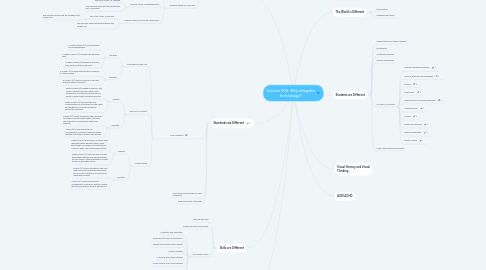
1. Teaching Should Be Different
1.1. Need to be able to use and integrate technology
1.2. Model technology
1.3. Make learning more exciting
1.4. Universal Design for Learning
1.4.1. Multiple Means of Engagement
1.4.1.1. This is the "Why" of learning
1.4.1.2. This principle works with the affective part of the brain
1.4.2. Multiple Means of Representation
1.4.2.1. This is the "What" of Learning
1.4.2.2. This principle deals with the recognition part of the brain
1.4.3. Multiple Means of Action and Expression
1.4.3.1. This is the "How" of learning
1.4.3.1.1. This principle works with the strategic part of the brain
1.4.3.2. This principle works with the strategic part of the brain
2. Standards are Different
2.1. ISTE Standards
2.1.1. Copyright and Fair Use
2.1.1.1. Students
2.1.1.1.1. 2. Digital Citizen (C) Demonstrating and understanding...
2.1.1.1.2. 2. Digital Citizen (D) Manage their personal data...
2.1.1.1.3. 2. Digital Citizen (B) Engage in positive, safe, legal and ethical behavior....
2.1.1.2. Educator
2.1.1.2.1. 3. Citizen: (A) Create experiences for learners to make positive....
2.1.1.2.2. 3. Citizen: (B) Mentor students in the safe, legal and ethical practices...
2.1.2. Safe Use of Internet
2.1.2.1. Student
2.1.2.1.1. Digital Citizen (B) Engage in positive, safe, legal and ethical behavior when using technology, including social interactions online or when using networked devices
2.1.2.1.2. Digital Citizen (C) Demonstrate and understanding of and respect for the rights and obligations of using and sharing intellectual property.
2.1.2.2. Educator
2.1.2.2.1. Citizen (C) Mentor students in the safe legal and ethical practices with digital tools and the protection of intellectual rights and property.
2.1.2.2.2. Citizen (D) Model and promote management of personal data and digital identity and protect student data privacy.
2.1.3. Cyberbullying
2.1.3.1. Student
2.1.3.1.1. Digital Citizen (B) Engage in positive, safe, legal and ethical behavior when using technology, including social interactions online or when using networked devices.
2.1.3.1.2. Digital Citizen (A) cultivate and manage their digital identity and representations and are aware of the permanence of their actions in the digital world.
2.1.3.2. Educator
2.1.3.2.1. Citizen (C) Mentor students in the safe legal and ethical practices with digital tools and the protection of intellectual rights and property
2.1.3.2.2. Citizen (D) Model and promote management of personal data and digital identity and protect student data privacy
2.2. Ohio Learning Standards for Early Childhood
2.3. Ohio Technology Standards
3. Skills are Different
3.1. Skills are Evolving
3.2. Need Real World Technology
3.3. 21st Century Skills
3.3.1. Creativity and Innovation
3.3.2. Communication and Collaboration
3.3.3. Research and Information Literacy
3.3.4. Critical Thinking
3.3.5. Nonlinear and Linear Thinking
3.3.6. Visual Literacy and Visual Thinking
3.3.7. Spacial Thinking
3.3.8. Digital-Age Reflection
4. Digital Age Reflection
5. The World is Different
5.1. Globalization
5.2. Changing work place
6. Students are Different
6.1. Characteristics of Digital Students
6.2. Multitaskers
6.3. multimedia oriented
6.4. Multiple Intelligence
6.5. All Types of Learners
6.5.1. Multiple Intelligence learners
6.5.2. Cultural, Ethnicity and languages
6.5.3. Autism
6.5.4. ADD/ADHD
6.5.5. Intellectual and Learning Disabilities
6.5.6. Learning Styles
6.5.7. At Risk
6.5.8. Gifted and Talented
6.5.9. Physical Disabilities
6.5.10. Special Needs
